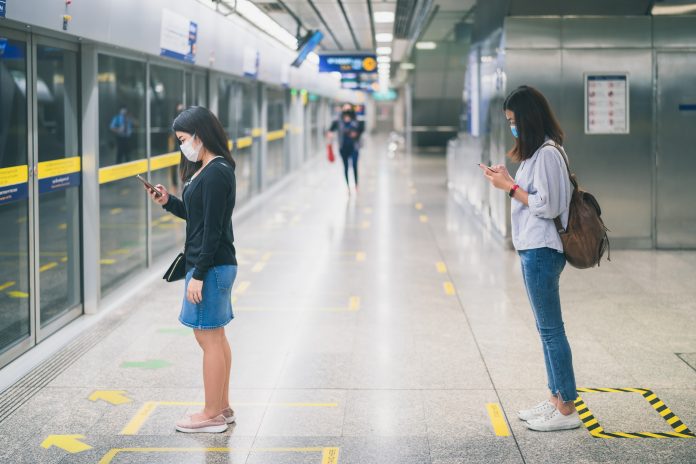Maintaining face mask mandates, between two to ten weeks after vaccination, could save almost $3 billion in direct medical costs across the US
Face masks are an efficient hygienic tool to prevent the spread of a viral infection, yet face mask mandates are being lifted everywhere across the U.S., despite less than 70% of the population being fully vaccinated against COVID-19.
Research finds that consistently maintaining face mask use until full vaccination thresholds are covered could benefit its healthcare system, potentially treating far fewer people for severe cases of COVID-19.
Vaccine coverage thresholds – for example 70 to 90% of people fully vaccinated – should be promoted and conducted before governments discard any mask mandates.
As the U.S. does not have nationalised healthcare, U.S. medical bills can be expensive for both the health recipients and providers. COVID-19 has displayed the vast cost of the pandemic when governments were unprepared for them, as well as how much the pandemic has overtaken treatments of other illnesses in hospitals due to priority.
Less than 45% of the U.S have received the booster vaccine, so immunity is lessened
Published in The Lancet Public Health, researchers suggest that consistently maintaining face mask use until, and even two to 10 weeks beyond, can significantly prevent a substantial number of COVID cases, hospitalizations, and deaths nationally.
This mandate can also help to save businesses, the healthcare system, insurance companies, taxpayers, as well as other people’s money.
Using computer simulation model of the entire U.S., researchers simulated the spread of COVID-19, subsequent outcomes of infection (like symptoms and hospitalisations), vaccination, face mask use at the levels seen in the U.S. from March to July of 2020, as well as the associated costs along the way.
Results from this highlighted that when the reproductive number of the virus (such as how contagious and infectious the variant is) is five – corresponding to the delta variant – as well as 80% of the population being fully vaccinated, maintaining face mask use until then could save a total of $2.9 billion in direct medical costs.
Overall, maintained face mask mandates could save a total of $20.1 billion in productivity losses, benefiting employers and taxpayers, as well as a total of $3.3 billion in direct medical costs and $23.4 billion in productivity losses.
This research highlights that maintaining face mask mandates for COVID is still worthwhile for employers, governments, and insurance companies, and that they should continue to invest into providing face masks and maintaining their use until two to 10 weeks after different target vaccination coverages have been reached.
Face masks help the healthcare system, patients, and insurance companies
The research additionally states that continuing face mask use for one more month beyond achieving 70% coverage by March provided additional benefits, averting around $1.5 billion in societal costs, $148.6 million in direct medical costs, $3.9 billion in productivity losses, and 856,000 cases less compared to if masks were not maintained for the additional month.
This provides evidence face masks mandates will not be required forever, just until immunity is high enough from the vaccines to protect societies – as well as providing greater protection to variants of COVID-19 which develop too.
Face masks provide better results with more infectious variants such omicron and its subvariant BA.2 also, where results suggested that when the reproductive number is 10 – corresponding to the omicron variant – maintaining face masks would avert $49.5 billion in societal costs (e.g., direct medical costs, productivity losses, face mask costs).
This went on to account for $5.2 billion in direct medical costs, $48.8 billion in productivity losses and 17.9 million cases compared to no mask use if 70% of the U.S. was fully vaccinated by March 1.
Overall, the study found that increasing face mask use by 10% above the levels seen in March to July 2020 could increase the cost savings and cases, hospitalizations and deaths averted by up to 20%.
Using more effective masks like N95 respirators could further decrease costs
Dr. Bruce Y. Lee, CUNY SPH professor, executive director of PHICOR, and the study’s senior author, said: “The messaging about face mask use has been inconsistent throughout the pandemic as there has been back and forth about the use of face masks.
“There has been a tendency to focus on one intervention at a time. First there was a focus on social distancing and then the focus turned to face mask wearing.
“Then, attention turned towards the COVID-19 vaccines once they came out. Instead, as long as the pandemic is continuing, there’s a need to consistently layer multiple interventions on top of each other since each complement and enhance each other.”
Dr. Peter Hotez, professor, dean, and co-author of the study, said: “Vaccines save lives but alone are not enough to get our society to a point where we can safely be free of COVID-19 requirements like face mask use yet.”
Study co-author Dr. Maria Elena Bottazzi, associate dean of the National School of Tropical Medicine at Baylor College of Medicine said: “The study’s results suggest that it could be economically worthwhile for businesses to provide and encourage face mask use.
“The results also provide targets to aim for in which we can drop the mask requirements indoors.”
Conclusively, anything which further increases COVID-19 coronavirus’ infectiousness – such as variants and subvariants – can decrease vaccine effectiveness – like waning immunity, lack of boosters, emerging variants – or increases social interactions only increased face masks’ value.











